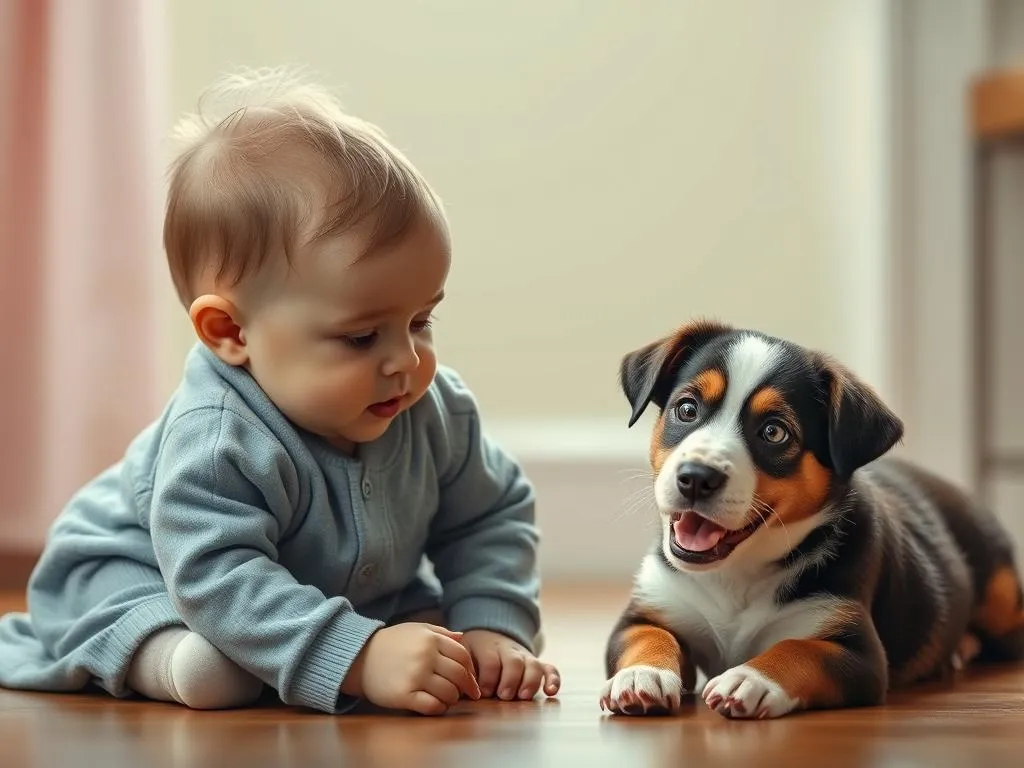
Welcoming a new baby into your home is an exciting time, but it can also be a period filled with uncertainty, especially if you already have a dog. The idea of introducing babies and dogs might raise concerns about safety and the potential for behavioral issues. However, with the right approach, both your baby and your furry friend can coexist harmoniously, creating a loving and nurturing environment for your family.
Having a dog in the household can provide numerous benefits for your baby, including companionship, emotional support, and valuable life lessons. But before diving into the process of introduction, it’s important to understand the dynamics between your baby and dog, prepare for the transition, and ensure safety and comfort for both parties.
Understanding the Dynamics: Babies and Dogs
The Benefits of Having Dogs with Babies
The companionship of a dog can significantly enrich a child’s early years. Studies have shown that children raised with dogs often develop a strong sense of empathy and responsibility. Here are some benefits of having dogs around babies:
-
Companionship and Emotional Support: Dogs can offer unconditional love and companionship, which can help children develop social skills and emotional intelligence. They often provide comfort during times of stress or change.
-
Teaching Responsibility and Empathy: Having a pet teaches children the importance of caring for another living being. They learn to be gentle, nurturing, and responsible, which are vital life skills as they grow.
Common Concerns Parents Have
While the benefits are clear, parents often have valid concerns regarding safety and health issues. Here are some common worries:
-
Safety Issues: Parents may fear that their dog could unintentionally harm their baby, especially if the dog is large or overly energetic.
-
Behavioral Changes in Dogs: Dogs may exhibit behavioral changes in response to the new family member, such as anxiety, jealousy, or aggression.
-
Allergies and Health Risks: Allergies to pet dander are a common concern, and parents must consider the potential for respiratory issues in children.
Preparing for the Introduction
Assessing Your Dog’s Temperament
Before you introduce your baby to your dog, it’s crucial to assess your dog’s temperament. Look for the following key traits:
-
Patience and Friendliness: Dogs that are naturally calm and friendly tend to adapt better to new situations.
-
Signs of Anxiety or Aggression: Pay attention to your dog’s body language. Signs of stress, such as growling, barking, or hiding, might indicate that your dog is not ready for the introduction.
Preparing Your Dog for the New Arrival
Preparation is key to a successful introduction. Here are some tips to get your dog ready for the new family member:
-
Training Tips for Dogs Pre-Baby: Start teaching your dog basic commands such as “sit,” “stay,” and “leave it.” This will help you manage their behavior when the baby arrives.
-
Creating a Calm Environment: Establish a quiet space in your home where your dog can retreat when they feel overwhelmed.
-
Adjusting Routines in Anticipation of the Baby: Dogs thrive on routine, so gradually introduce changes in their schedule, such as feeding times and walk durations, to reduce anxiety.
The Introduction Process
Timing the Introduction
Timing is crucial when introducing babies and dogs. Consider the following factors:
-
When is the Best Time?: Ideally, introduce your dog to your baby when your dog is calm and relaxed, such as after a walk or play session.
-
Dog’s Age and Training: Younger dogs may have more energy, while older dogs may be more set in their ways. Consider your dog’s personality and training level when planning the introduction.
Step-by-Step Introduction Techniques
The introduction process should be gradual and controlled. Follow these steps:
-
Initial Scent Introduction: Before a face-to-face meeting, let your dog sniff a blanket or clothing item that belongs to the baby. This helps them get used to the baby’s scent.
-
Controlled Face-to-Face Meeting: Hold your baby in your arms while someone else holds the dog on a leash. Keep it short and positive, gradually increasing the time as your dog becomes more comfortable.
-
Monitoring Body Language and Reactions: Watch for signs of stress or discomfort from both the baby and the dog. Use treats to reward calm behavior.
Creating Positive Associations
To ensure a positive introduction, focus on creating positive associations:
-
Rewarding the Dog for Calm Behavior: Use treats and praise when your dog behaves calmly around the baby.
-
Using Treats and Toys: Engage your dog with their favorite toys or treats during the introduction to create a positive experience.
Ensuring Safety and Comfort
Setting Boundaries
Establishing boundaries is essential for ensuring the safety and comfort of both your baby and dog:
-
Designating Safe Spaces: Create designated areas in your home where your dog can retreat away from the baby, and vice versa.
-
Teaching the Dog to Respect Baby’s Space: Use commands to teach your dog to stay at a safe distance when the baby is playing or sleeping.
Supervision Protocols
Always supervise interactions between your dog and baby:
-
Guidelines for Supervision: Make it a rule to never leave your baby and dog alone together. Always be present during their interactions.
-
Signs to Watch For: Be mindful of stress signals such as growling, barking, or a stiff body posture in your dog. If you notice these signs, intervene immediately.
Safety Gear and Tools
Utilizing safety gear can help prevent accidents:
-
Leashes, Gates, and Other Safety Equipment: Use baby gates to keep the dog separated from the baby when necessary. Leashes can also be helpful during introductions.
-
Crate Training and Its Benefits: Training your dog to be comfortable in a crate can provide them with a personal space to retreat to when feeling overwhelmed.
Ongoing Management and Training
Continued Training for Your Dog
Training doesn’t stop once the baby arrives. Continuously reinforce positive behavior:
-
Reinforcing Positive Behavior: Consistently reward your dog for good behavior around the baby to encourage them to remain calm.
-
Basic Commands for Safety: Teach your dog commands like “leave it” and “drop it” to ensure safety during interactions.
Monitoring Interactions as Baby Grows
As your baby grows, so will their curiosity and mobility. Be prepared to adjust your supervision:
-
Adjusting Supervision: As your baby learns to crawl or walk, be extra vigilant during interactions and provide guidance.
-
Understanding Developmental Stages: Recognize that both your baby and dog will go through developmental stages that may affect their behavior.
Addressing Behavioral Issues
Behavioral issues may arise as your baby and dog interact. Here’s how to address them:
-
Common Behavioral Problems: Some dogs may exhibit jealousy or anxiety. Identify any concerning behaviors early on.
-
When to Seek Professional Help: If your dog shows signs of aggression or severe anxiety, consider consulting a professional trainer or behaviorist for guidance.
The Long-Term Benefits of Their Relationship
Emotional and Mental Health Advantages
The bond between your baby and dog can greatly enhance their emotional and mental well-being:
-
Strengthening the Bond: As they grow together, the connection between your baby and dog can deepen, fostering a sense of companionship.
-
Benefits of Companionship: Studies show that children raised with pets often have lower levels of stress and anxiety.
Teaching Life Lessons
Having a dog can teach your child valuable lessons:
- Responsibility, Empathy, and Nurturing Behavior: Caring for a pet instills a sense of responsibility and empathy in children, preparing them for future relationships.
Family Dynamics and Bonding
Dogs contribute to family unity and happiness:
- How Pets Contribute to Family Happiness: The presence of a dog can enhance family dynamics, providing opportunities for shared activities and bonding moments.
Conclusion
Successfully introducing babies and dogs can lead to a harmonious family life filled with love, laughter, and learning. By preparing both your dog and baby for this new chapter, monitoring their interactions, and fostering a safe environment, you can create a nurturing space where both can thrive. Remember to be patient and proactive in addressing any issues that may arise.
The bond between your child and your dog can be one of the most rewarding aspects of family life, teaching valuable lessons and providing lifelong companionship. Embrace the journey, and enjoy the beautiful moments that come from having both a baby and a dog in your home.









